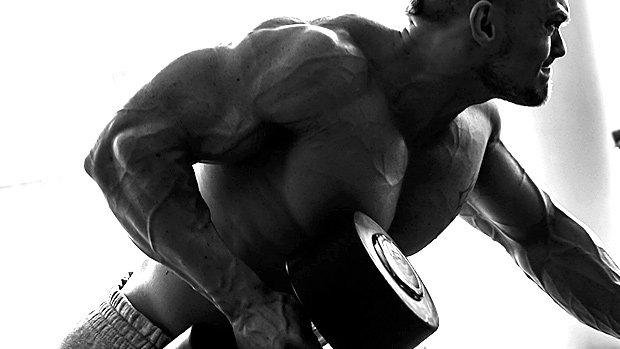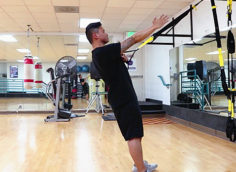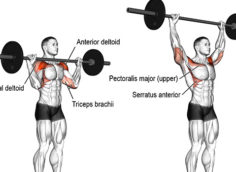When it comes to building size and strength, the importance of dedication and attention to detail is undeniable. But some people take it too far. There's no need to have an aneurysm trying the get all the details right. Sure, certain things do matter, like showing up consistently and lifting weights. But some things matter less than you think, like these.
Perfect form is a myth. From limb length ratios to bodyweight to joint structure and innate mobility, every lifter has a unique build. Moreover, no one is perfectly symmetrical. So why try to match your body to some arbitrary ideal?
Granted, there are some rules that should rarely, if ever, be broken, like rounding out on a deadlift or squat, or arching excessively on an overhead press. After all, these positions are known mechanisms of injury.
But if you feel more comfortable setting up with your feet wider than shoulder width in a squat, then have at it, as long as your knees don't cave in. If it's more natural for you to have one foot slightly in front of the other and toed out when you swing a kettlebell, go to town. Just make sure you're still distributing your weight evenly from front to back and side to side.
With so much person-to-person variation, there simply can't be such a thing as one perfect form, only perfect form for you as an individual, and a range of acceptable techniques across all lifters. So – within reason – do what feels right, textbook form be damned.
Suppose your program calls for a cable triceps extension, but you're at a gym that doesn't have a cable system. Don't panic. For most exercises, you can find a suitable replacement.
In lieu of the triceps extension, switch to a band, which will provide an almost identical stimulus. If the gym doesn't have bands either, do a bodyweight triceps extension with a suspension trainer or bar in a power rack.
Bodyweight Triceps Extensions
Cables and bands aren't the only interchangeable implements. Don't have kettlebells? Use dumbbells. The power racks are all taken? Use the Smith machine or jam a spare bar into the corner of a room to make a landmine unit. No available benches? Floor press instead.
The point is, while there are certainly differences from one piece of equipment to the next, they're generally less substantial than people think. Unless you're a competitive powerlifter who's a few weeks out from competition, equipment substitutions aren't going to make or break your gains.
Giant sets and circuit training can be a challenge in a crowded gym, even if you're being considerate about not monopolizing several pieces of equipment. Nonetheless, they are possible, as long as you're willing to be flexible with exercise order.
Imagine you carefully plan to alternate between lower body, upper body, and core exercises (e.g., box jumps, pull-ups, goblet squats, and front planks). It won't ruin your workout if your next round is done out of order because a piece of equipment is in use.
Order does sometimes matter, especially with exercises that are inherently complex or high-risk. Don't be an idiot and try to max out on a box jump after a heavy set of squats. (Actually, there's never a good reason to max out on a box jump, but that's a different story.) And if you have to plank after pull-ups because your goblet-squat dumbbell got scooped, don't sweat it.
Say your arm workout calls for three sets of 10-12 reps with the 90-pound preset barbell. Upon reaching the rack, you discover the 90-pounder is nowhere in sight. Should you search high and low for it, only to come up empty and cool down completely from your workout? No. Just use the 80-pound bar and do a few extra reps, even if your rep totals now fall outside the beloved (and mythical) hypertrophy range of 8-12.
Load and volume exist on a continuum. Frankly, as long as you're getting close to failure, the difference between 10 and 13 reps isn't that important. Of course, don't just choose weights on a whim. If your goal is size, yet you struggle to complete 4 reps with the weight you've chosen, your training volume will likely be insufficient for stimulating growth.
Sure, you should hit muscles from a variety of angles. Consider the pecs. Incline bench, flat bench, and decline bench all offer a slightly different training stimulus. There's a common misconception, however, that every chest day should include all three. By attempting to work all three angles of the bench press, you stand to diminish your returns on one or more of them.
The smarter approach is to hit two of those angles during any given workout. That way, you can put 100 percent effort into each exercise, rather than giving subpar effort on all three or having nothing left by the time you get to the third.
Your musculoskeletal and nervous systems can only take so much pounding, which means that you can't fit every exercise into every workout or training program. In fact, this is the essence of periodization. For example, you might spend 4-6 weeks working barbell flat bench and dumbbell incline bench, then switch to decline and close-grip incline. Cycling exercises allows for perpetual progress, as opposed to inevitable stagnation from trying to do too much.
Based on my one-rep max (1RM) overhead press of 135 pounds, I should, according to most percentage calculators, be able to do 5 reps at 115 and 10 at 100. The strange thing is, I don't come anywhere close to those rep totals with submaximal loads.
There's a good reason for my apparent shortcomings: the calculators aren't fortune tellers. They merely provide mathematical estimates – estimates that tend to get worse as the number of reps increase. The truth is, every lifter is different, and so is every exercise. Strength tends to fluctuate from day to day based on accumulated stress and even state of mind.
Women tend to get more reps at higher percentages of their 1RM than the equations predict. Men get fewer. Could that mean many women are afraid to go too heavy, or in general men have less muscular endurance? Maybe.
Regardless, there's no need to get hung up on percentages. Instead, the better strategy is to figure out what your individual repetition maxes are for the lifts you perform most often. Make a table of all the lifts and reps, from your 1RM all the way to 10. Keep those numbers handy, and every time you do one of the lifts, attempt to shatter one of your personal records.
Don, my client, is a devout lifter. He hates missing a workout. He's consistently in the gym four days a week, week after week. That adds up to about 17 workouts per month and over 200 workouts per year. Let's say, though, that there's one week where he's absolutely swamped. In the past, he's pushed through weeks like this, only to wind up getting sick and missing extended periods of time, both at the gym and from work.
This time, for his health and his sanity, he chooses sleep over training on two consecutive days. Don is annoyed with the interruption in training, but is it really that big a deal? He ends up with 15 workouts for the month, which represents just a 12% drop in volume from his typical routine. In addition, he maintains his mental health and avoids getting too run down.
Sometimes life gets in the way, and that's okay. Of course, you have to be honest with yourself about your training situation. If you're only making it to the gym once or twice a week at baseline, then skipping a day is going to have more significant consequences than it would for Don.
In the grand scheme of things, it's consistency and training volume over the long haul that matters, not compulsive adherence during any given day or week. Focus on the things that matter, like getting stronger week in and week out. Ignore the things that don't.





